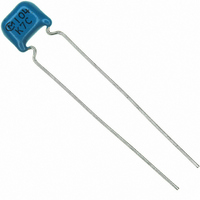RDER72J104K8K1C11B Murata Electronics North America, RDER72J104K8K1C11B Datasheet - Page 13

RDER72J104K8K1C11B
Manufacturer Part Number
RDER72J104K8K1C11B
Description
CAP CER 100000PF 630V X7R RADIAL
Manufacturer
Murata Electronics North America
Series
RDEr
Datasheets
1.RPEF51H104Z2K1A03B.pdf
(2 pages)
2.RDEE41H104M0K1C03B.pdf
(3 pages)
3.RDER72J682K2K1C11B.pdf
(39 pages)
4.RDER72J104K8K1C11B.pdf
(1 pages)
Specifications of RDER72J104K8K1C11B
Capacitance
0.1µF
Voltage - Rated
630V
Tolerance
±10%
Temperature Coefficient
X7R
Mounting Type
Through Hole
Operating Temperature
-55°C ~ 125°C
Features
High Voltage
Applications
General Purpose
Package / Case
Radial
Size / Dimension
0.217" L x 0.295" W (5.50mm x 7.50mm)
Thickness
4.00mm Max
Lead Spacing
0.197" (5.00mm)
Lead Style
Flat Bent
Lead Free Status / RoHS Status
Lead free / RoHS Compliant
Ratings
-
Other names
490-4821
Available stocks
Company
Part Number
Manufacturer
Quantity
Price
Company:
Part Number:
RDER72J104K8K1C11B
Manufacturer:
PANASONIC
Quantity:
30 000
!Note
• This PDF catalog is downloaded from the website of Murata Manufacturing co., ltd. Therefore, it’s specifications are subject to change or our products in it may be discontinued without advance notice. Please check with our
• This PDF catalog has only typical specifications because there is no space for detailed specifications. Therefore, please approve our product specifications or transact the approval sheet for product specifications before ordering.
sales representatives or product engineers before ordering.
!Note
No.
1
2
3
4
5
6
7
8
9
Operating Temperature
Range
Rated Voltage
Appearance
Dimension and Marking
Dielectric
Strength
Insulation
Resistance
Capacitance
Q/Dissipation Factor (D.F.)
Capacitance
Temperature
Characteristics
• Please read rating and !CAUTION (for storage, operating, rating, soldering, mounting and handling) in this catalog to prevent smoking and/or burning, etc.
• This catalog has only typical specifications because there is no space for detailed specifications. Therefore, please approve our product specifications or transact the approval sheet for product specifications before ordering.
Item
Between
Terminals
Body
Insulation
Between
Terminals
Capacitance
Change
Temperature
Coefficient
Capacitance
Drift
Temperature Compensating Type High Dielectric Constant Type
-55 to +125˚C
See previous pages
No defects or abnormalities
See previous pages
No defects or abnormalities
No defects or abnormalities
C V 0.047µF : 10,000MΩ min.
C G 0.047µF : 500MΩ • µF min.
C : Nominal capacitance
Within the specified tolerance
30pF min. : Q U 1,000
30pF max. : Q U 400+20C
C : Nominal capacitance (pF)
Within the specified tolerance
(Table A on last column)
Within the specified tolerance
(Table A on last column)
Within T0.2% or T0.05pF
(whichever is larger)
Specifications
Char. X7R : -55 to +125˚C
Char. Y5V : -30 to +85˚C
Char. X7R : 0.025 max.
Char. Y5V : 0.05 max.
Within the specified tolerance
(Table B on last column)
Specifications and Test Methods
The rated voltage is defined as the maximum voltage
which may be applied continuously to the capacitor.
When AC voltage is superimposed on DC voltage, V
or V
within the rated voltage range.
Visual inspection
Visual inspection, Vernier Caliper
The capacitors should not be damaged when DC
voltages of 300%* of the rated voltage are applied
between the terminals for 1 to 5 sec.
(Charge/Discharge current V 50mA)
*250% for char. X7R, Y5V
The capacitor is placed in a
container with metal balls of 1mm
diameter so that each terminal,
short-circuited, is kept
approximately 2mm from the balls
as shown in the figure, and 250%
of the rated DC voltage is
impressed for 1 to 5 sec. between
capacitor terminals and metal
balls. (Charge/Discharge current
V 50mA)
The insulation resistance should be measured with a
DC voltage not exceeding the rated voltage at normal
temperature and humidity and within 2 min. of charging.
(Charge/Discharge current V 50mA)
The capacitance, Q/D.F. should be measured at 25˚C
at the frequency and voltage shown in the table.
The capacitance change should be measured after 5
min. at each specified temperature stage.
(1) Temperature Compensating Type
The temperature coefficient is determined using the
capacitance measured in step 3 as a reference. When
cycling the temperature sequentially from step 1
through 5 (-55 to +125˚C) the capacitance should be
within the specified tolerance for the temperature
coefficient and capacitance change as shown in Table
A. The capacitance drift is calculated by dividing the
differences between the maximum and minimum
measured values in step 1, 3 and 5 by the cap. value in
step 3.
(2) High Dielectric Constant Type
The ranges of capacitance change compared with the
25˚C value over the temperature ranges as shown in
Table B should be within the specified ranges.
Item
0-P
Frequency
Voltage
, whichever is larger, should be maintained
Step
Capacitance
1
2
3
4
5
Test Method
1000pF and
AC0.5 to 5V
1T0.1MHz
Continued on the following page.
(r.m.s.)
below
–
Temperature (˚C)
125±3
-55±3
-25±2
-25±2
-25±2
AC1T0.2V
more than
1T0.1kHz
1000pF
(r.m.s.)
Approx. 2mm
Metal balls
P-P
C49E.pdf
11
10.3.8
1






















